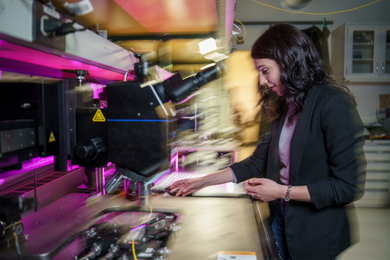An electrical engineer was gluing images cut from magazines onto construction paper to create replicas of the World Trade Center twin towers in shades of pink.
"I thought this was the nicest event [of those commemorating Sept. 11] because it was personal and not very conventional," Ana Jovanovic said as she glued an image of a green ribbon to a twin tower. The ribbon looked like a long, flowing evening gown hanging off the tower. Near the bottom of her collage, the outline of a large heart encircled the twins. "I'd much rather express myself visually than verbally," she said.
Jovanovic, who lived in New York at the time of the terrorist attacks, was among the 25 or so MIT community members who participated in the Sept. 11 Open Art Studio in Lobby 10 organized by Kay Walsh, an administrative assistant in the Center for Environmental Health Services, and sponsored by Artists Behind the Desk and the MIT Council for the Arts.
Walsh, a New Yorker and an art therapist by training, believes in the transformative power of art. She had been holding workshops at her church in the aftermath of the terrorist attacks "to help people express themselves--to help their souls communicate with their brains," she said.
She organized the open studio in Lobby 10 as her gift to the MIT community.
People passing through the lobby glanced over at the round tables arrayed with ribbons and clay, crayons and construction paper, glue, scissors and magazine pages. Occasionally someone would stop to read the "Messages of Hope" board and maybe select a marker to leave his own words. Others, most of them women, were drawn to the art tables.
Christina Huang, a freshman from Queens who crafted a clay sculpture of the Twin Towers, was in math class at the Bronx High School of Science when the terrorist attacks occurred last year.
"The principal came onto the loudspeaker and she was telling us about how there was a plane crash," said Huang. "'Don't worry,' she said, 'it's under investigation. But if you have family who work in the World Trade Center, you can come down to the office now.' She really didn't tell us much about what was going on."
Huang left school early and went to a friend's house in the Bronx. "We turned on the TV and the sky was flooded with this gray smoke. It was terrifying. A guy with us--his mom worked on the 92nd floor of the World Trade Center--was crying."
At this, Huang leaned forward and added quietly, "I'd never seen a male cry before." The friend's mother made it out of the tower.
As Huang spoke, her hands were busy with her small sculpture. The towers, gray and striated, stood tall on a flat, round base of gray with red clay streaming through it. The sculpted digits "9 / 11" were attached to the front of the base.
As she struggled to attach a red, white and blue ribbon, Walsh approached, handing her a folded piece of cardboard that could run behind and under the sculpture's base. Huang glued the ribbon to the cardboard, and together they inserted a pushpin to hold the cardboard to the clay base.
Huang placed her sculpture on a small table near the west wall of the lobby and hurried off. Nearby, completed collages and drawings hung from the wall. A drawing of a black stick figure had only one distinguishing feature: a red heart in a black barred box. At the bottom, the artist had written: "What are you doing differently?" One collage was a pale blue piece of construction paper with torn strips of black crepe paper hanging loosely from it, as if blowing in a breeze.
A few other clay sculptures rested on a small ledge. One hanging sculpture with heart-shaped leaves strung on a gold ribbon with a note saying "for the flight crews" was attached to the ledge just under the word "victory" carved into the marble wall.






